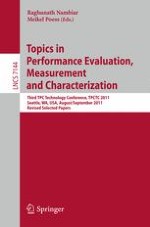2012 | Buch
Topics in Performance Evaluation, Measurement and Characterization
Third TPC Technology Conference, TPCTC 2011, Seattle, WA, USA, August 29-September 3, 2011, Revised Selected Papers
herausgegeben von: Raghunath Nambiar, Meikel Poess
Verlag: Springer Berlin Heidelberg
Buchreihe : Lecture Notes in Computer Science
